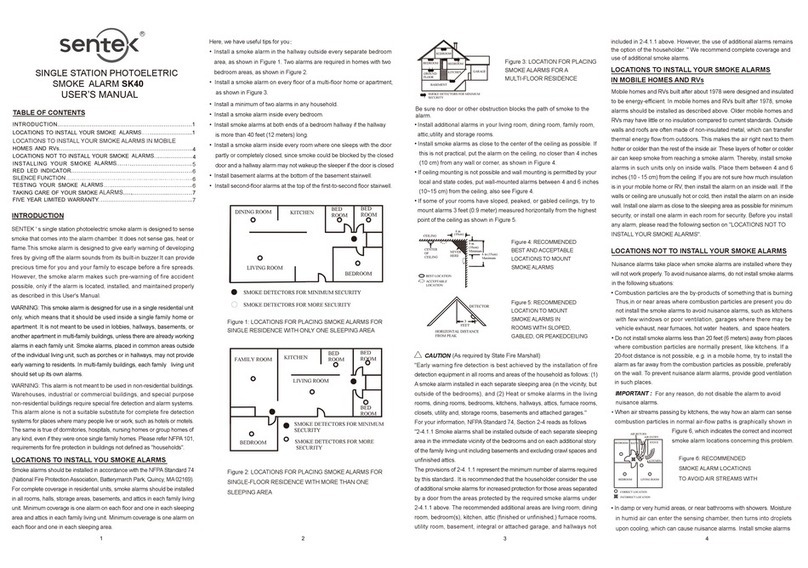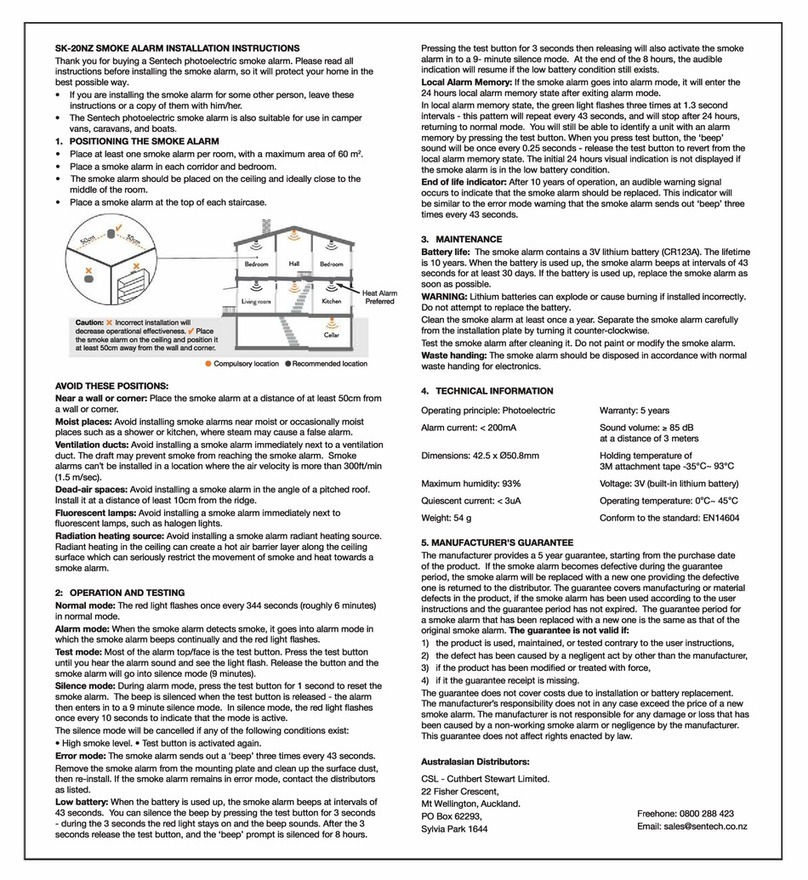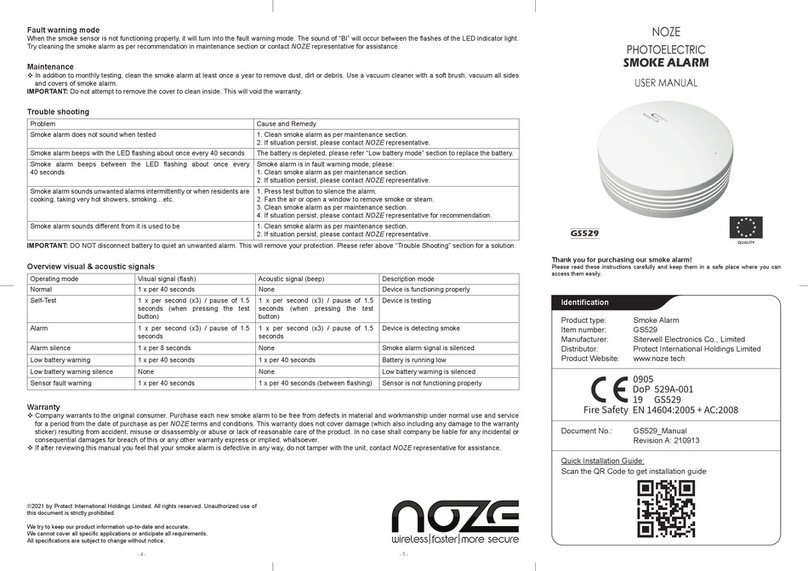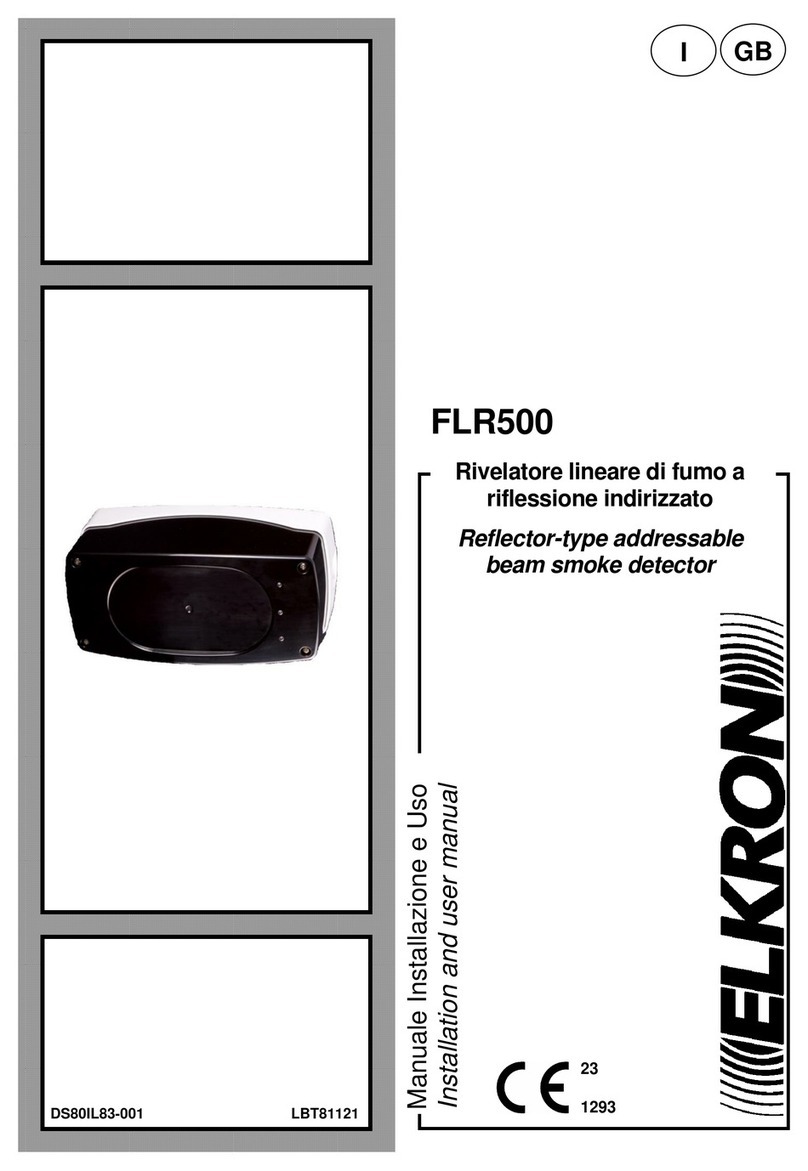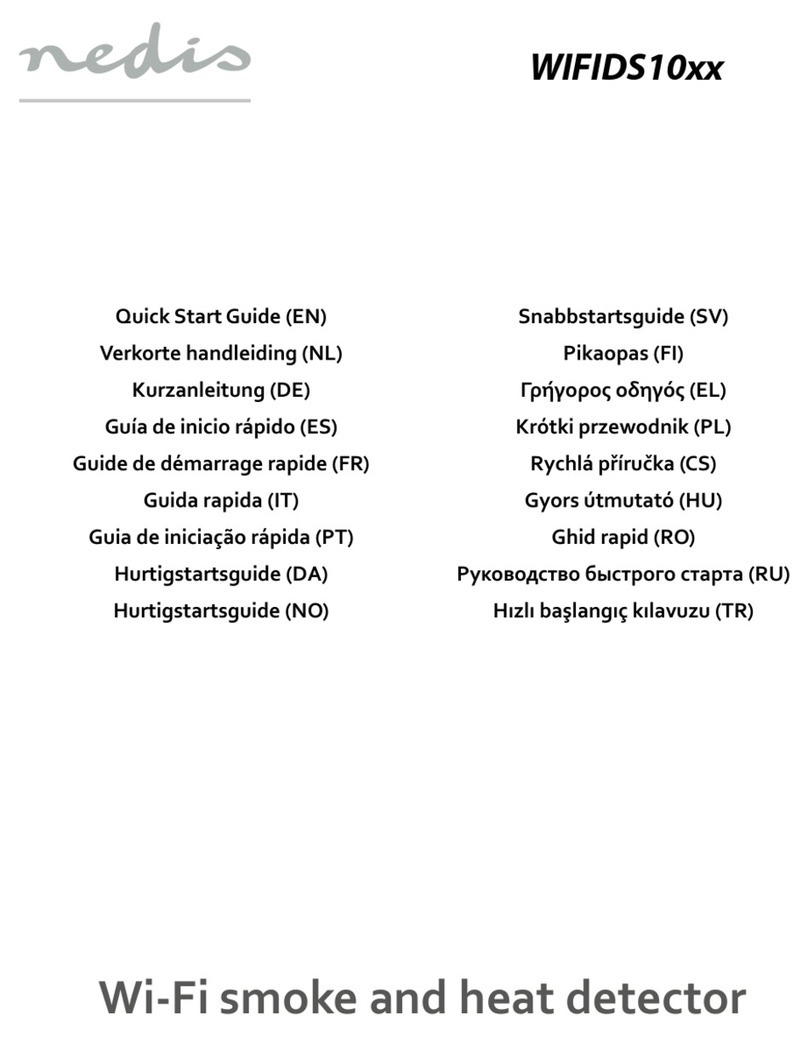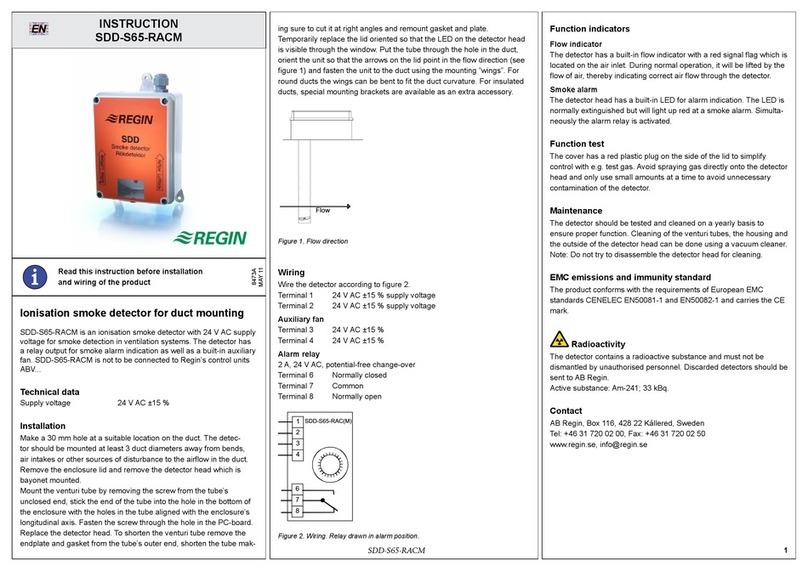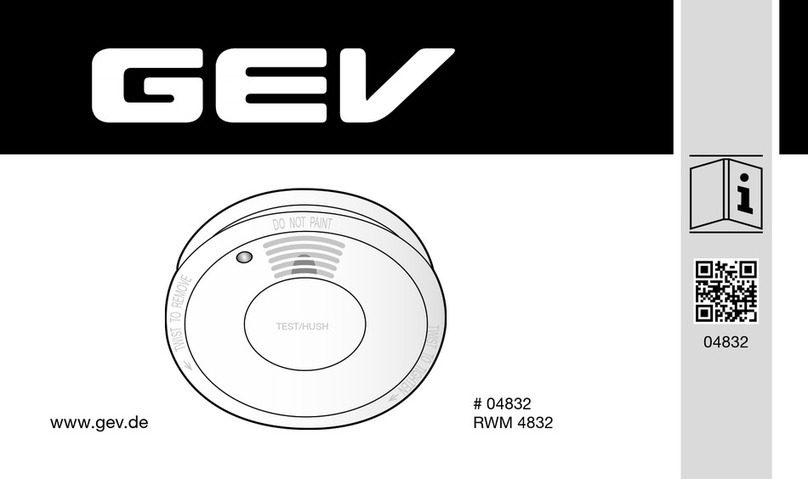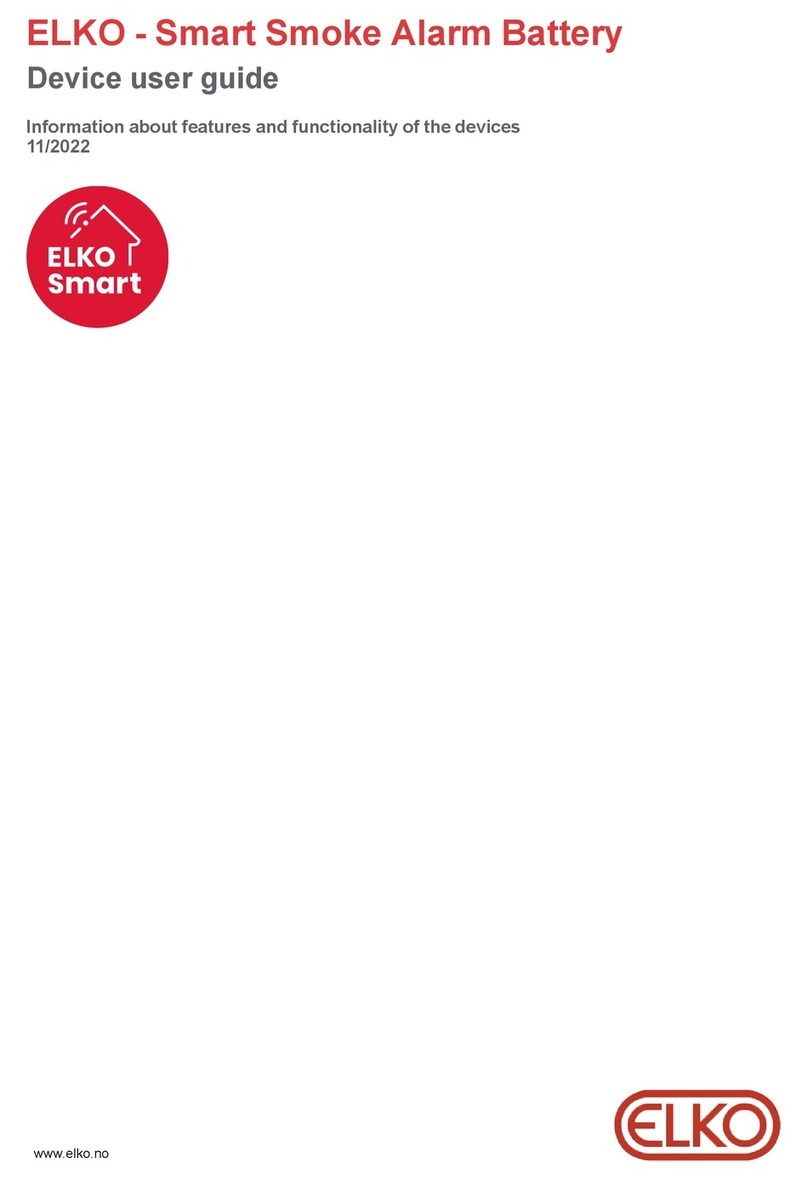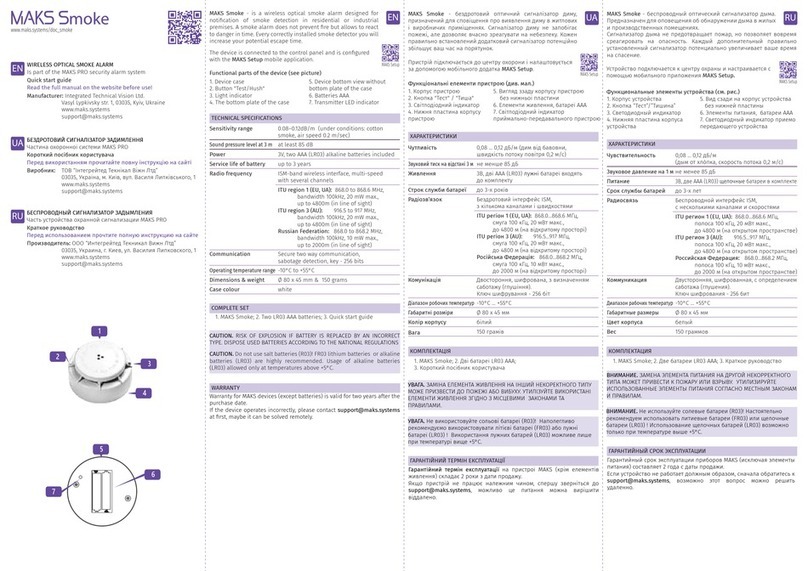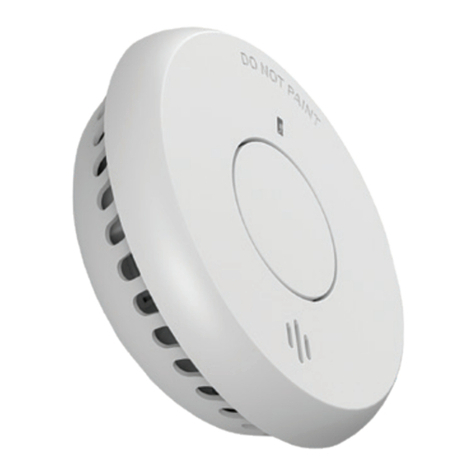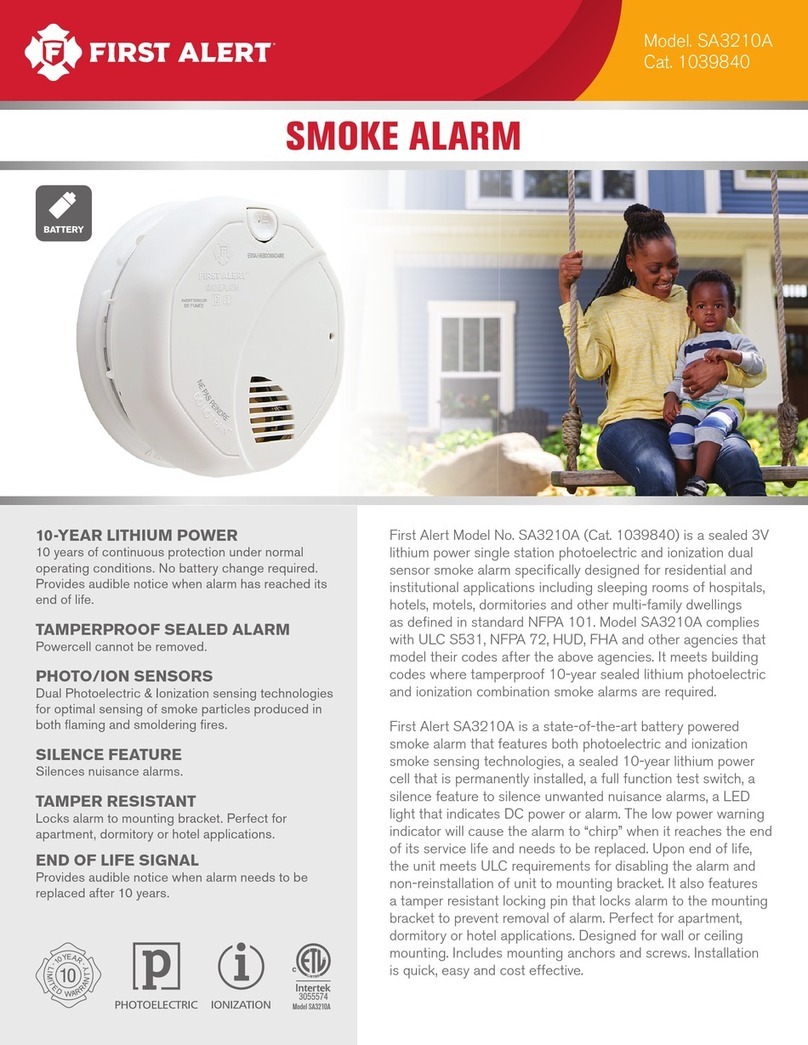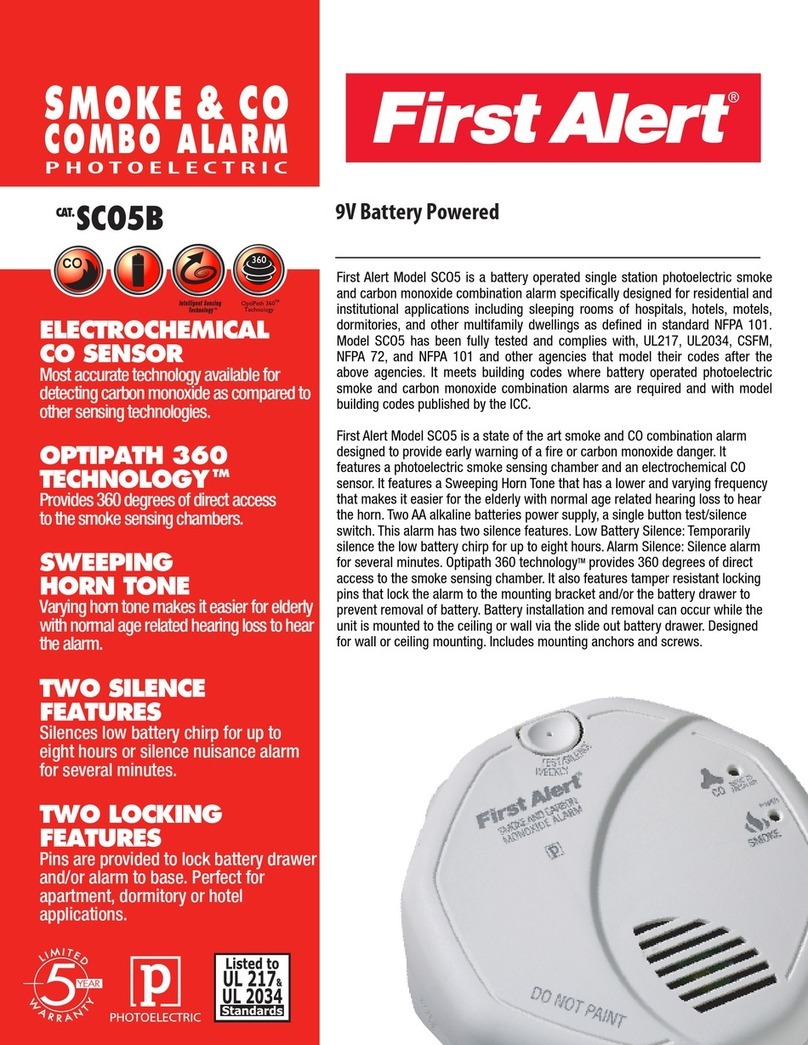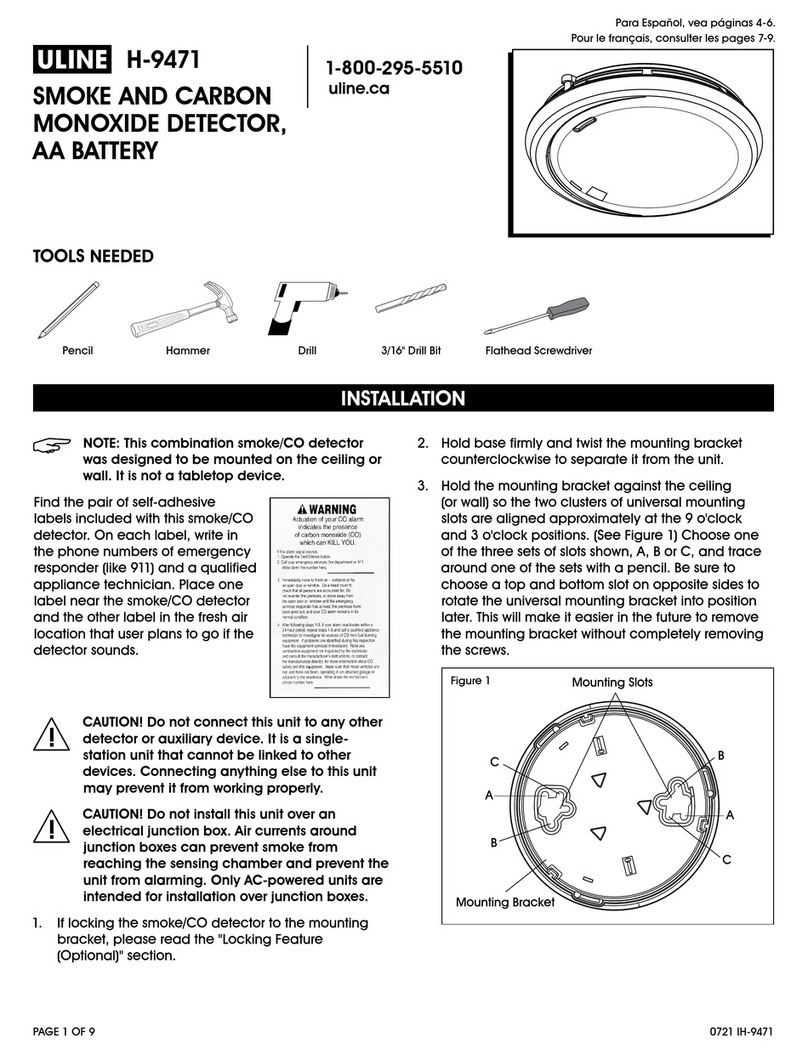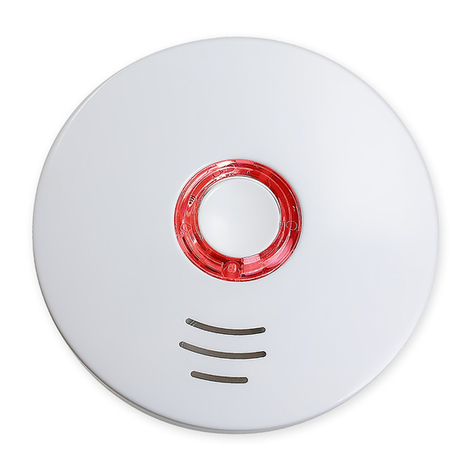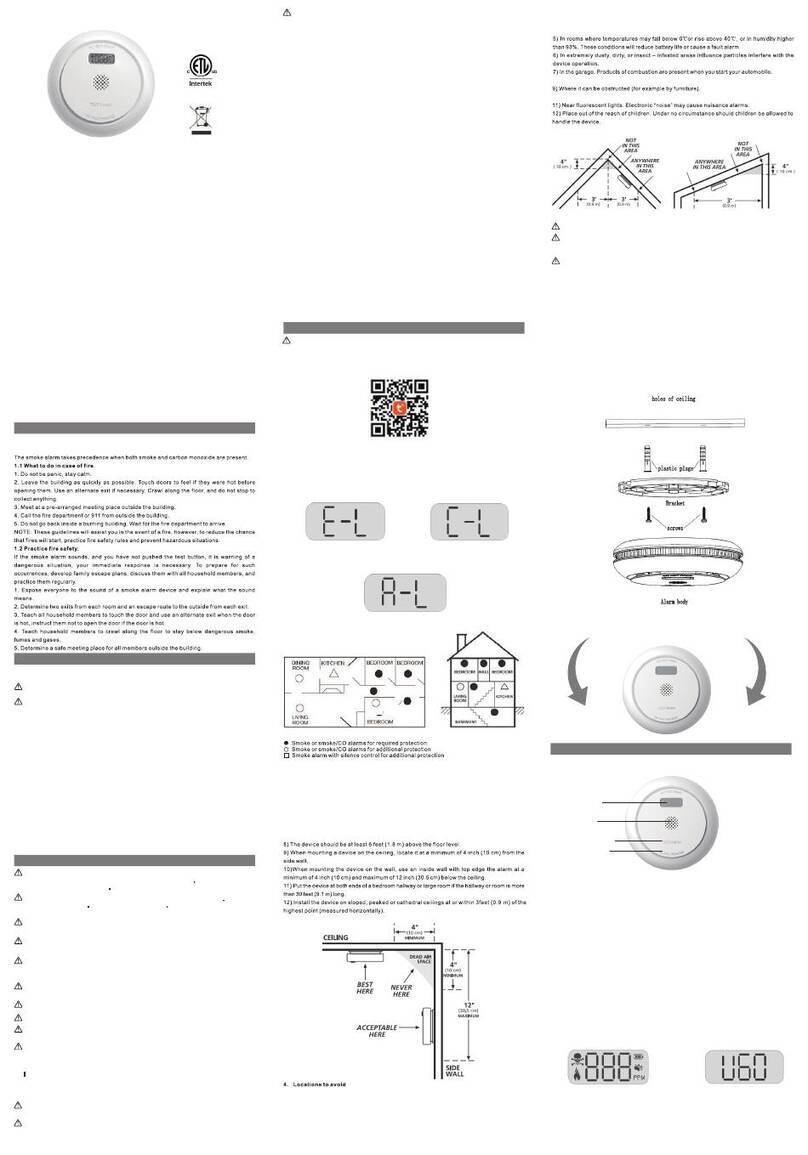Sentek SK50 User manual

SENTEK ' s single station photoelectric smoke alarm is designed to sense
smoke that comes into the alarm chamber. It does not sense gas, heat or
flame.This smoke alarm is designed to give early warning of developing
fires by giving off the alarm sounds from its built-in buzzer.It can provide
precious time for you and your family to escape before a fire spreads.
However, the smoke alarm makes such pre-warning of fire accident
possible, only if the alarm is located, installed, and maintained properly
as described in this User's Manual.
•Install a minimum of two alarms in any household.
•Install a smoke alarm inside every bedroom.
•Install smoke alarms at both ends of a bedroom hallway if the hallway
is more than 40 feet (12 meters) long.
•Install a smoke alarm inside every room where one sleeps with the door
partly or completely closed, since smoke could be blocked by the closed
door and a hallway alarm may not wakeup the sleeper if the door is closed
•Install basement alarms at the bottom of the basement stairwell.
• Install second-floor alarms at the top of the first-to-second floor stairwell.
Figure 1: LOCATIONS FOR PLACING SMOKE ALARMS FOR
SINGLE RESIDENCE WITH ONLY ONE SLEEPING AREA
Figure 2: LOCATIONS FOR PLACING SMOKE ALARMS FOR
SINGLE-FLOOR RESIDENCE WITH MORE THAN ONE
SLEEPING AREA
WARNING: This smoke alarm is designed for use in a single residential unit
only, which means that it should be used inside a single family home or
apartment. It is not meant to be used in lobbies, hallways, basements, or
another apartment in multi-family buildings, unless there are already working
alarms in each family unit. Smoke alarms, placed in common areas outside
of the individual living unit, such as porches or in hallways, may not provide
early warning to residents. In multi-family buildings, each family living unit
should set up its own alarms.
WARNING: This alarm is not meant to be used in non-residential buildings.
Warehouses, industrial or commercial buildings, and special purpose
non-residential buildings require special fire detection and alarm systems.
This alarm alone is not a suitable substitute for complete fire detection
systems for places where many people live or work, such as hotels or motels.
The same is true of dormitories, hospitals, nursing homes or group homes of
any kind, even if they were once single family homes. Please refer NFPA 101,
requirements for fire protection in buildings not defined as "households".
Smoke alarms should be installed in accordance with the NFPA Standard 74
(National Fire Protection Association, Batterymarch Park, Quincy, MA 02169).
For complete coverage in residential units, smoke alarms should be installed
in all rooms, halls, storage areas, basements, and attics in each family living
unit. Minimum coverage is one alarm on each floor and one in each sleeping
area and attics in each family living unit. Minimum coverage is one alarm on
each floor and one in each sleeping area.
Here, we have useful tips for you:
•Install a smoke alarm in the hallway outside every separate bedroom
area, as shown in Figure 1. Two alarms are required in homes with two
bedroom areas, as shown in Figure 2.
• Install a smoke alarm on every floor of a multi-floor home or apartment,
as shown in Figure 3.
LOCATIONS TO INSTALL YOU SMOKE ALARMS
INTRODUCTION
Figure 3: LOCATION FOR PLACING
SMOKE ALARMS FOR A
MULTI-FLOOR RESIDENCE
LOCATIONS NOT TO INSTALL YOUR SMOKE ALARMS
Be sure no door or other obstruction blocks the path of smoke to the
alarm.
•Install additional alarms in your living room, dining room, family room,
attic,utility and storage rooms.
•Install smoke alarms as close to the center of the ceiling as possible. If
this is not practical, put the alarm on the ceiling, no closer than 4 inches
(10 cm) from any wall or corner, as shown in Figure 4.
•If ceiling mounting is not possible and wall mounting is permitted by your
local and state codes, put wall-mounted alarms between 4 and 6 inches
(10~15 cm) from the ceiling, also see Figure 4.
•If some of your rooms have sloped, peaked, or gabled ceilings, try to
mount alarms 3 feet (0.9 meter) measured horizontally from the highest
point of the ceiling as shown in Figure 5.
Figure 4: RECOMMENDED
BEST AND ACCEPTABLE
LOCATIONS TO MOUNT
SMOKE ALARMS
Figure 5: RECOMMENDED
LOCATION TO MOUNT
SMOKE ALARMS IN
ROOMS WITH SLOPED,
GABLED, OR PEAKEDCEILING
included in 2-4.1.1 above. However, the use of additional alarms remains
the option of the householder. " We recommend complete coverage and
use of additional smoke alarms.
• In damp or very humid areas, or near bathrooms with showers. Moisture
in humid air can enter the sensing chamber, then turns into droplets
upon cooling, which can cause nuisance alarms. Install smoke alarms
"Early warning fire detection is best achieved by the installation of fire
detection equipment in all rooms and areas of the household as follows: (1)
A smoke alarm installed in each separate sleeping area (in the vicinity, but
outside of the bedrooms), and (2) Heat or smoke alarms in the living
rooms, dining rooms, bedrooms, kitchens, hallways, attics, furnace rooms,
closets, utility and, storage rooms, basements and attached garages."
For your information, NFPA Standard 74, Section 2-4 reads as follows
"2-4.1.1 Smoke alarms shall be installed outside of each separate sleeping
area in the immediate vicinity of the bedrooms and on each additional story
of the family living unit including basements and excluding crawl spaces and
unfinished attics.
The provisions of 2-4. 1.1 represent the minimum number of alarms required
by this standard.. It is recommended that the householder consider the use
of additional smoke alarms for increased protection for those areas separated
by a door from the areas protected by the required smoke alarms under
2-4.1.1 above. The recommended additional areas are living room, dining
room, bedroom(s), kitchen, attic (finished or unfinished,) furnace rooms,
utility room, basement, integral or attached garage, and hallways not
Mobile homes and RVs built after about 1978 were designed and insulated
to be energy-efficient. In mobile homes and RVs built after 1978, smoke
alarms should be installed as described above. Older mobile homes and
RVs may have little or no insulation compared to current standards. Outside
walls and roofs are often made of non-insulated metal, which can transfer
thermal energy flow from outdoors. This makes the air right next to them
hotter or colder than the rest of the inside air. These layers of hotter or colder
air can keep smoke from reaching a smoke alarm. Thereby, install smoke
alarms in such units only on inside walls. Place them between 4 and 6
inches (10 - 15 cm) from the ceiling. If you are not sure how much insulation
is in your mobile home or RV, then install the alarm on an inside wall. If the
walls or ceiling are unusually hot or cold, then install the alarm on an inside
wall. Install one alarm as close to the sleeping area as possible for minimum
security, or install one alarm in each room for security. Before you install
any alarm, please read the following section on "LOCATIONS NOT TO
INSTALL YOUR SMOKE ALARMS".
LOCATIONS TO INSTALL YOUR SMOKE ALARMS
IN MOBILE HOMES AND RVs
Figure 6: RECOMMENDED
SMOKE ALARM LOCATIONS
TO AVOID AIR STREAMS WITH
CAUTION
(As required by State Fire Marshall)
Nuisance alarms take place when smoke alarms are installed where they
will not work properly. To avoid nuisance alarms, do not install smoke alarms
in the following situations:
• Combustion particles are the by-products of something that is burning
Thus,in or near areas where combustion particles are present you do
not install the smoke alarms to avoid nuisance alarms, such as kitchens
with few windows or poor ventilation, garages where there may be
vehicle exhaust, near furnaces, hot water heaters, and space heaters.
•Do not install smoke alarms less than 20 feet (6 meters) away from places
where combustion particles are normally present, like kitchens. If a
20-foot distance is not possible, e.g. in a mobile home, try to install the
alarm as far away from the combustion particles as possible, preferably
on the wall. To prevent nuisance alarm alarms, provide good ventilation
in such places.
IMPORTANT :
For any reason, do not disable the alarm to avoid
nuisance alarms.
• When air streams passing by kitchens, the way how an alarm can sense
combustion particles in normal air-flow paths is graphically shown in
Figure 6, which indicates the correct and incorrect
smoke alarm locations concerning this problem.
R
SINGLE STATION PHOTOELETRIC
SMOKE ALARM SK50
6
6
7
6
5
LOCATIONS TO INSTALL YOUR SMOKE ALARMS IN MOBILE
ALARMS.....
TABLE OF CONTENTS
4
ALARMS
ALARMS
ALARMS
SILENCE FUNCTION
ALARMS
4

Never remove batteries to stop a nuisance alarm. Pressing
the test button and after releasing it, the alarm will be hushed about 9
minutes. Then Open a window or fan the air around the alarm to get rid of
the smoke. The alarm will turn itself off when the smoke is gone. If
nuisance alarms persist, attempt to clean the alarm as described in this
User's Manual.
Do not stand close to the alarm when the alarm is sounding.
The alarm is loud in order to wake you in an emergency. Too much
exposure to the horn at close range may be harmful to your hearing.
Model SK50 smoke alarms are to be mounted on the ceiling or on the
wall if necessary. Since SK50 smoke alarm is a single-station type, it
cannot be linked to other alarms.
Read "LOCATIONS TO INSTALL YOUR SMOKE ALARMS" and
"LOCATIONS NOT TO INSTALL YOUR SMOKE ALARMS" section in
this Manual first, then decide where to install an alarm.
Please follow these steps to install your smoke alarm:
1. At the place where you are going to install the alarm, draw a horizontal
line six inches long.
2.Remove the mounting bracket from your unit by rotating it
counterclockwise.
3. Place the bracket so that the two longest hole slots are aligned on the
line. In each of keyhole slots, draw a mark to locate a mounting plug
and screw.
4. Remove the bracket.
5. Using a 3/16-inch (5mm) drill bit, drills two holes at the marks and
insert plastic wall plugs. Put the alarm away from getting plaster dust
on it when you drill holes for mounting.
INSTALLING YOUR SMOKE ALARMS
at least
10 feet (3 meters) away from bathrooms.
•In very cold or very hot areas, including unheated buildings or outdoor
rooms. If the temperature goes above or below the operating range
of smoke alarm, it will not work properly. The temperature range for
your smoke alarm is 32 °F to 120 °F (0 °C to 50 °C).
• In very dusty or dirty areas, dirt and dust can build up on the alarm's
sensing chamber, to make it overly sensitive. Additionally, dust or dirt
can block openings to the sensing chamber and keep the alarm from
sensing smoke.
• Near fresh air vents or very drafty areas like air conditioners, heaters
or fans, fresh air vents and drafts can drive smoke away from smoke
alarms.
•Dead air spaces are often at the top of a peaked roof, or in the corners
between ceilings and walls. Dead air may prevent smoke from reaching
an alarm. See Figures 4 and 5 for recommended mounting locations.
•In insect-infested areas. If insects enter an alarm's sensing chamber,
they may cause a nuisance alarm. Where bugs are a problem, get rid
of them before putting up an alarm.
•Near fluorescent lights, electrical "noise" from fluorescent lights may
cause nuisance alarms. Install smoke alarms at least 5 feet (1.5meters)
from such lights.
WARNING:
WARNING:
The red LED, as the ALARM indicator, is featured with the alarm. It
can be seen through the test button on the cover of the alarm. When
red LED flashes once 32 seconds, it indicates the alarm under normal
operation. When smoke alarm senses smoke and simultaneously
sounds an audible alarm, the red LED will flash very frequently, once
0.5 seconds.
RED LED INDICATOR
TESTING YOUR SMOKE ALARMS
SILENCE FUNCTION
Test the alarm weekly by pressing the test button with your figure until
the buzzer sounds. This is the only way to be sure that alarm is
working correctly. If the alarm fails to test properly, have it repaired or
replaced immediately.
never use an open flame to test the alarm. You may set
fire to damage the alarm, as well as your home. The built-in test switch
accurately tests all the alarm functions.
When you are not testing the unit and the alarm buzzer
sounds a loud continuous sound, this means the alarm has sensed
WARNING:
WARNING:
Do not test the alarm with smoke in silence mode, otherwise
the alarm will not alarm.
NOTE:
To stop the nuisance alarm, silence function is available to use. Pressing
the test button and after releasing it, the alarm will be hused about 9
minutes and the LED indicator flashes once each 8 seconds (in normal
working status, the LED flashes once each 32 seconds). During this time,
the alarm becomes insensiive to the smoke. Wait for the alarm to exit
the silence status and the alarm will continue to detect the smoke again.
The alarm could be caused by a nuisance situation. Cooking smoke or
adusty furnace, sometimes called “friendly fires”can cause the alarm
to sound. If this happens, open a window or fan the air to remove the
smoke or dust. The alarm will turn off as soon as the air is completely
clear.
If the alarm buzzer begins to beep once 32 seconds at the same time
the LED flashing, this signal means that the alarm’s battery is weak.
Replace new battery immediately. Keep fresh batteries on hand for this
purpose.
If nuisance alarms keeping coming from alarm, you should
check whether the alarm’s location is adequate. Refer to section
“WHERE TO INSTALL SMOKE ALARM” Move your alarm if it is not
located properly. Clean the alarm as describe above.
Clean alarm cover when it gets dirty. First open the cover and remove
battery. Hand-wash cover with cloth dampened with clean water. Dry it
with lint-free cloth. Do not get any water on the alarm components.
Replace the battery, and close cover. Test alarm to make sure that
battery works correctly.
FIVE YEAR LIMITED WARRANTY
To keep your alarm in good working order, you must test the alarm
weekly, as referring to section “TESTING YOUR SMOKE ALARM”
9Volt GP1604S Carbon-Znic battery with SK50 for one year lifetime
operation. Replace the alarm battery once a year or immediately when
the low battery “beep” signal sounds once 32 seconds at same time
the LED flash.
TAKING CARE OF YOUR SMOKE ALARMS
Do not disconnect the battery from the alarm.This will remove
your protection from fires.
NOTE:
Do not use any other kind of battery. This alarm may
not operate properly with other kind of battery.
Normal, the LED flashes every 32 seconds. A beep or chirp occurring
at half time of LED flashes, it indicates the alarm is fault.
Open the cover and vacuum the dust off the alarm’s sensing chamber
at least once a year. This can be done when you open the alarm to
change the battery. Remove battery before cleaning. To clean alarm,
use soft brush attachment to your vacuum. Carefully remove any dust
on alarm components, especially on the openings of the sensing
chamber. Replace battery after cleaning. Test alarm to make sure
battery is correctly. Check to make sure there are no obstruction inside
the sensing chamber. If there is any dust in the sensing chamber insert
a toothpick from the back to the front.
WARNING:
NOTE:
In order to protect your right, please keep the original
NOTE:
smoke or combustion particles in the air. Be sure that the alarm buzzer
is a warning of a possible serious situation, which requires your
immediate attention.
warranty for this smoke alarm. No agent, representative, dealer, or
employee of the company has the authority to increase or alter the
obligations or limitations of this warranty. The company’s obligation of
this warranty shall be limited to the repair or replacement of any part of
the alarm which is found to be defective in materials or workmanship
under normal use and service during the five year period commencing
with the data of purchase.
During the initial one-year period commencing with the data of
purchase, such repair or replacement shall be made without charge.
During the latter four years of the warranty period, such repair or
replacement shall be made at a charge to the customer not to exceed
the manufacturer’s cost. Units in need of repair should be returned,
shipping prepaid, to customer. Service Department, Ningbo Sentek
Electronic Co., Ltd.-448 Yingchun Road, Wangchun Industrial Zone,
Ningbo City 315175, Zhejiang ,China.
The company shall not be obligated to repair or replace units, which
are found to be in need of repair because of damage, unreasonable
use, modifications, or alterations occurring after the data of purchase.
The duration of any implied warranty, including that of merchantability
or fitness for any particular purpose, shall be limited to the period of
five years commencing with the data of purchase. In no case shall the
Company be liable for any consequential or incidental damages for
breach of this or any other warranty expressed or implied whatsoever,
even if the loss or damage is caused by the company’s negligence or
fault. Some states do not allow the exclusion or limitation of incidental
or consequential damages, so the above limitation or exclusion may
not apply to you. SENTEK makes no warranty, expressed or implied,
written or oral, including that of merchantability or fitness for any
particular purpose, with respect to the batteries. This warranty gives
you specific legal rights, and you may also have other rights which vary
from state to state.
purchase receipt for the proof of buying SENTEK alarm from our
authorized dealers. NO warranty can be offered without the original
purchase receipt.
Smoke Sensitivity 0.08~0.13dB/m
Alarm sound level 85dB/3meters
Battery Life One year\9Volt GP1604S battery
Quiescent current <8uA
Alarm current <20mA
Temperature Range -10℃~ 55℃
Humidity 0 to 95%RH, no condensation or icing
Weight 116.5g (with baery)
Dimension 97x97x32mm
Manufacturer: Sentek Electronics Co., Ltd.
#448 Yingchun road, Wangchun Industrial Park, Ningbo City
315175, Zhejiang, China
Tel: 86-574-8715 3117 Fax: 86-574-8715 5951
DWG No. K04402104 Rev.1.1
SK50 is designed complying with EN14604. SENTEK warrants its
enclosed Smoke Alarm, but not the battery, to be free from defects in
materials and workmanship under normal use and service for a period
of five Years from date of purchase. SENTEK makes no other express
6. Using the two screws and plastic wall plugs (all supplied), attach the
bracket to the wall.Plug the power connector into other connector
attached at the back of the alarm . It is keyed so it can only be installedone
way. Tug the connector to be sure that it is plugged in correctly. The
connector can be removed at any time by holding the connector body
firmly and pulling it out.
7. Line up the slot of the bracket and the alarm. Push the alarm onto
the mounting bracket and turn it clockwise to fix it into place. Pull
outward on the alarm to make sure it is securely attached to the
mounting bracket.
For replacement battery, use Gold Peak 1604P 1604S,1604A;
Eveready 522,216,1222; Duracell MN1604; Golden Power G6F22,
GL6F22A; Pairdeer 6F22,6LR61,CR-V9; Huiderui CP9V; EVE CR9V/P.
NOTE:

SK50
4401309
K04402104
徐珊珊
徐珊珊
宋文轩
李志强
刘琼洁
备注:A3,80g黑白双面印刷(对折12等份)
2019/02/14
更新版次 (REV.)签名 (SIGNATURE)日期 (DATE)
零件名称
PART NAME
单位
UNT
版本
REV.
比例
SCALE
图纸编号
PART NO.
MM 1.1
1.0
1:1品 号
P/N
日期
DATE
日期
DATE
日期
DATE
日期
DATE
日期
DATE
日期
DATE
材料
MATERIAL
设计
DESIGN
审核
CHEDKED
核准
APPROVED
工艺
PROCESS
品质
QUALITY
业务
SALES
产品型号
PRDDUCT ITEM
PAPER
修订记录 (REVISION HISTORY)
新发行(New issue)
徐珊珊 2020/11/23
2020/11/23
刘 胜 2020/11/23
2020/11/23
2020/11/23
2020/11/23
田 强 2020/11/23
1.1 灵敏度更改为0.08~0.13dB/m
宁波尚泰电子有限公司
NINGBO SENTEK ELECTRONICS CO.,LTD.
R
说明书 (Installation Instructions)
Other Sentek Smoke Alarm manuals

